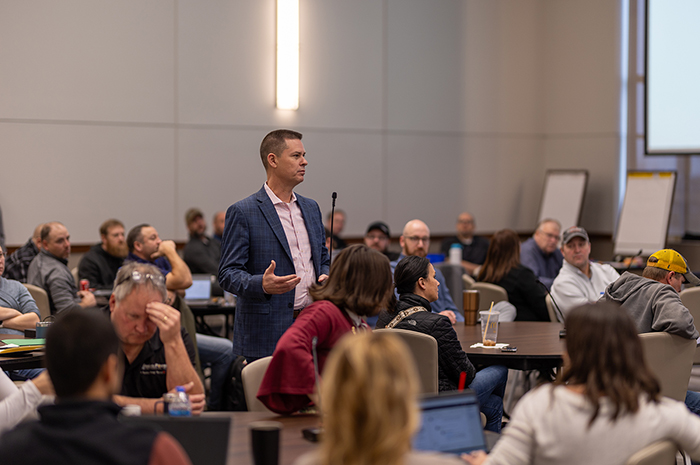Down to the wire
The grid reliability alarms are ringing. How is Minnkota Power Cooperative preparing?
A maze of colorful lines and dots are sprawled across the 20-foot-tall screen towering over Terry Peoples and Jeremy Wiegandt. The digital depiction of Minnkota’s electric grid may appear intimidating to most, but on this day, the bright lights and streams of real-time data provide a sense of calm inside Minnkota’s energy control center. The power was flowing reliably, field crews were working safely and the phone lines were quiet.
But well outside the walls of this secure facility, there’s a growing challenge that may require Minnkota’s power system operators (PSOs) to do something they’ve never done before: intentionally turn the lights out for member-consumers as part of requirements to avoid a potential large-scale grid collapse.
“We’re literally the people with our finger on the button,” said Peoples, as he scrolled through the cooperative’s power delivery system from his desk chair. “It doesn’t surprise us that this situation is becoming more real. We have a good plan in place, but we know it would be chaotic if the time comes. Level heads have to prevail.”

Minnkota does not operate on the regional grid alone. The cooperative is interconnected with other utilities across a 15-state footprint from North Dakota to Louisiana through an organization called MISO. In an emergency grid event, MISO has the ability to take control of all utility systems and make decisions they deem necessary to maintain stability and bring balance to the supply and demand for electricity. That includes requiring Minnkota PSOs to push the off button on a rotating basis until conditions improve.
“It’s really been eye-opening,” said Wiegandt, a power system operator trainee in his first year on the job. “Things have completely flipped since I started here and they’re still changing. I’m still learning how things work now, but we’re all constantly learning about what the future might look like.”
While every effort is made to avoid interrupting service to end-use members, Minnkota can be required by MISO to turn power off to some member-consumers to help prevent a catastrophic, extended failure of the larger electrical grid. Even if Minnkota has the resources in place to meet its members’ needs, challenges in other parts of the MISO footprint can and do create impacts.

‘Immediate and serious challenges’
The potential for grid reliability issues is increasing primarily due to the speed at which the United States is transitioning toward intermittent resources without retaining the stability provided by baseload coal, nuclear and natural gas power plants. As more dependable power plants are retired without adequate replacement, the margin for error continues to shrink.
In February 2024, MISO released an update to its Reliability Imperative that highlighted “immediate and serious challenges to grid reliability.” The report also identifies that “the transition that is underway to get to a decarbonized end state is posing material, adverse challenges to electric reliability.” Grid regulators, including the North American Electric Reliability Corporation (NERC) and the Midwest Reliability Organization (MRO), have drawn similar conclusions in their reports released in the past few months.
“We’re reading the same reports as everyone else,” said Brandon Trontvet, Minnkota’s System Operations and EMS Manager. “We’re trying to prepare ourselves as best as possible knowing that reliability issues are a lot more likely than they’ve ever been before.”

Trontvet oversees the system operations team, which includes the energy control center. He says lessons learned from Winter Storm Uri, the 2021 grid event in Texas that caused the largest controlled power outage in U.S. history, prompted his team to thoroughly evaluate and update its existing firm load shed plan, which identifies how PSOs will respond in a grid emergency event. Close coordination and collaboration with staff from the member cooperatives and Northern Municipal Power Agency participants throughout the process were critical in positioning the plan for a rapidly evolving environment.
“We’ve always had a firm load shed plan, but throughout the years it’s never been used in real life,” Trontvet said. “We dedicated time to working with the members to understand the loads we have on our system and determine how we can best minimize impacts, especially to critical infrastructure and essential services.”
Trontvet says the plan matches up with the steps taken by MISO once it declares a Maximum Generation Event, which calls on all available resources to operate. The five-step process incorporates a variety of strategies, including public appeals for energy conservation to stabilize the situation before issuing directives to initiate controlled outages. Additionally, MISO reserves the right to move directly to firm load shed without warning based on system conditions.
Increasing volatility
With reliability at greater risk, the MISO market – where Minnkota buys and sells energy and capacity – is responding with pricing that is becoming increasingly unpredictable.
“The volatility that we’re seeing is about 10 to 20 times greater than what we saw five years ago,” said Dan Trebil, Minnkota energy supply manager. “We used to see prices trade within a pretty narrow band, but now we’re seeing prices go from negative-$30 to $2,000 – sometimes within the same hour.”

One change expected within the next year is to move the market pricing cap from $3,500/megawatt-hour (MWh) to $10,000/ MWh – a jump that would create major financial consequences for buying energy from the market during an extreme event. “It sends a message to market participants that you don’t want to be short in this market,” Trebil said. “Eight hours of market exposure at $10,000/MWh would be a significant impact to Minnkota. And it’s not outside the realm of possibility.”
Although the challenges are growing, the first step toward improving the situation is bringing the issues to the forefront and having a dialogue between policymakers, regulators, utilities and other key stakeholders.
“It’s refreshing to see MISO and others publicly recognize that there are issues with not only grid reliability, but also the pace of resource retirements versus additions,” Trebil said.




...



